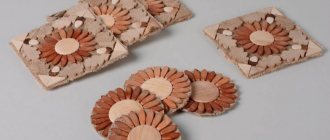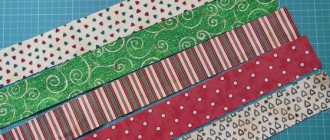Reads: 844
Reading time: 7 min.
no comments
If you love the most original things, then patchwork is for you. In such an outfit it is simply impossible to go unnoticed - patchwork clothing ideas for women become the very highlight that must certainly be in the image.
Don’t think that patchwork is only appropriate for outrageous looks or is only suitable for bohemians. Items made from scraps can harmoniously fit into a rather discreet outfit for every day.
What is patchwork
Craftsmen call patchwork many types of needlework, in which diverse parts are combined into one finished product. If we limit ourselves to wardrobe items, then patchwork is a technique for creating a canvas from individual flaps. From such fabric you can cut and sew a thing of any style.
There are several types of patchwork:
- Traditional or English, which uses flaps of the same size and shape.
- Сrazy (translated as “crazy”) - here randomly shaped flaps are sewn together, creating fancy ornaments (often the crazy technique involves joining parts with a zigzag seam and additional decoration of products with beads and seed beads).
- Quilting – bedspreads and blankets are often made using this technique; the products are supplemented with lining and insulation; outerwear is often found using the quilting technique.
- Knitted patchwork - not scraps of fabric are used, but knitted motifs specially created for a specific idea.
- Japanese patchwork - thematic images, most often landscapes, are made from multi-colored patches.
- Imitation is a product made of printed fabric that imitates patchwork.
The advantage of patchwork sewing is that an ultra-fashionable item can be sewn from almost nothing by cutting old clothes, bed linen, and leftover fabric into pieces. Let's see how to properly combine patchwork items with other details of the image, and evaluate fashionable couture solutions.
Fashion brands
Famous brands and fashion houses actively promote patchwork and regularly demonstrate such models as part of ready-to-wear and even haute couture shows.
The photo shows a patchwork style in denim from the Tom Ford brand collection in the form of light flared trousers. You can make this model yourself using parts from 2-3 pairs of old jeans:
The Chloe brand presented the public with a light chiffon midi skirt, made from large fragments of material with completely different prints.
Missoni uses details with geometric patterns, combining them into semi-classic jackets and trousers. Things look discreet thanks to the harmoniously selected colors:
Givenchy offers fashionistas a sweater in dark blue shades made from knitted squares:
Sportmax have released a bright sweatshirt made from scraps of knitwear and footer in different sizes.
The composition looks unified thanks to the monochromatic elastic cuffs and the same elastic along the bottom edge of the product. The elastic band acts as a frame that holds all the variety of flaps inside.
Of course, not all the looks you see on the catwalk need to be replicated exactly. Fashion designers boldly combine several patchwork style items in one set, completely different in theme. In life, it is best to wear patchwork items with items of restrained style and neutral shades.
Pattern
It is best to make patterns according to your size, taking them from some magazine or website on needlework. But if you don't have the ability to make copies and print out pattern sheets, then you can do things a little differently. Use an old thin jacket or a sweater or shirt that fits you, but has completely lost its appearance. Carefully cut it into pieces along the seams, separating the back, shelves, sleeves, and collar. Cut the shelves and back so that when sewing you get a yoke. Iron all the pieces well and use them instead of paper patterns.
Lay out the patterns on the panels that were intended for them. Place the shredded panels with the wrong side up so that the chalk or pencil you will use to outline the outline is not visible. Circle all the details. When you cut them out, do not forget to add 1 centimeter along the contour for the seams. Measure the length of the shelves along the edge and cut out two strips as follows:
A student at the Vietnam Police Academy shared how she takes care of her facial skin.
A Brazilian travels 36 km by bike every day to take his loved one home.
Smooth and fresh skin: dermaplaning, or why a woman needs to shave her face
- set aside the length of the shelf;
- set aside a shelf width equal to 8-10 centimeters, which is made up of double the width of the plank.
When cutting out each rectangle, do not forget to also add 1 centimeter along the contour for the seams.
Don't forget to cut out the collar - two pieces with seam allowances. You will also need two pockets and two flaps for them. You can take them from old trousers or a skirt, rather than cutting the parts yourself. And leave a strip of scraps that you will need to decorate the bottom edge.
Coat
A patchwork-style coat is a rather impressive-sized product, so it should be complemented with the most modest elements possible. If you do not want to distort the proportions of the silhouette, choose something sewn from small scraps. Large blocks arranged asymmetrically are suitable for fashionistas with a curvy or disproportionate figure.
Wear a multi-colored oversized cocoon coat with dark gray skinny jeans and black low-top boots. Accessories include a knitted beanie hat and a black tote bag.
A long coat made of patchwork with a variety of prints can be worn with a white shirt or blouse and boots that match one of the colors present on the coat.
A cropped coat made of fluffy patches in pastel shades can be worn with a plain cloche hat and knee-high boots with a tight top.
Wear a patchwork coat reminiscent of a blanket or plaid with simple pale blue jeans and taupe chunky boots.
A coat in a single color scheme can be complemented with a thin, monochromatic but bright scarf or neckerchief, while shoes and bags should be in neutral colors that are not conspicuous and act as a background.
This coat does not go well with all things; choose the most discreet tones, plain materials, and discreet styles. The coat will be the central element of the image; it is already a spectacular product; you should not overload the look with additional details or prints.
Dress
Dresses in the patchwork style are presented in both boho-style models and more traditional solutions. These can be summer light sundresses or insulated options that can be worn with turtlenecks and various jackets.
This sleeveless sheath dress, which uses patches of white, black and cocoa au lait, can be worn over a crisp white turtleneck, paired with black heeled ankle boots and a creamy neutral handbag.
Accessorize a light flared dress with a belt with ¾-length midi sleeves with maximally open sandals and a straw hat.
Wear a fitted warm sundress in red-brown tones with a white shirt and boots the color of dark chocolate.
Pair this boho dress with crochet motifs with Indian-inspired sandals, lots of bangles and a woven handbag.
Shortened dress models can be safely worn with over the knee boots and stocking boots, and there is no need to hide part of the dress under a jacket.
A flared, lightweight sundress can be used as a skirt by wearing a loose, waist-length denim polo blouse over it. With this outfit, you can try on white sneakers or sneakers.
If a patchwork dress seems too bold to you, choose or sew a model in which only a few details are sewn from scraps. For example, the skirt of a dress can be plain, and the upper part can be made of patches or vice versa. Sleeves or even arbitrary inserts of different sizes can be made from the flaps.
LiveInternetLiveInternet
https://www.livemaster.ru/topic/1488673-delaem-busy-s-narodnoj-kukolkoj
I would like to share my experience in creating textile beads with the Vepsian folk doll. Many people have probably seen or made similar beads with a doll of a slightly different design, however, my version is significantly different because I use hand-sewn textile beads and a doll of a different shape. After studying this master class, you can not only repeat the proposed version of the beads, but also make a separate traditional doll for a game, gift or Christmas tree decoration. I will also tell you in detail how you can sew a neat fabric bead.
A little about the Vepsian doll. I’ll immediately disappoint lovers of amulets: the Vepsian doll is not such, it’s just a play doll that a six-year-old girl made for ethnographers in 1975. More precisely, the girl made three play dolls, which are kept in the collection of the Russian Ethnographic Museum in St. Petersburg. For a long time, the museum has had an ethnoclub “Paraskeva”, whose talented craftswomen have the opportunity to work with funds. It was they who, about twenty years ago, brought to light replicas of Vepsian dolls, which “went among the people” and became overgrown with a lot of legends. And today this is the most reliable information about this doll, not only in my opinion, but also in the opinion of famous “masters” of folk dolls.
Beads with a doll attract a lot of attention, so you need to immediately decide in what situations you will wear them. Typically, fabric beads are worn with a folk costume or worn with clothes made of linen or cotton fabric during festivals, summer vacation walks, and master classes. Little girls also love them very much. And they are quite suitable as baby sling beads for baby’s games if, in addition to textile beads, you take simple wooden beads and firmly connect all the components.
So, let's begin. I slightly changed the design of the doll and put the scarf on her head not at the very end of production, but during the process. This turns out, in my opinion, more accurately. If you are making a doll not for beads, but on its own, then a scarf is tied to it at the end of the work. And pay attention that all rectangular parts are cut strictly along the grain or weft thread, so that the raw kula dress “fringes” evenly. The entire doll is tied with one thread, that is, during the work the thread is not cut off and does not come off the ball.
You will need:
1. A rectangular piece of light-colored fabric for the head, approximately 7.5 x 7.5 cm in size (if it’s 7.5 x 8 cm, it’s not a big deal).
2. Three scraps of main fabric for a doll’s dress, 7 x 7 cm.
3. Two scraps of additional fabric for handles, 7 x 7 cm. They are not in the photo, because when I took the photo, I forgot about the handles, I only remembered during the process. I made the handles from the same burgundy fabric as the scarf (triangular flap in the photo).
4. Triangular shawl scrap. To prepare it, take a square with a side of 8 cm and cut it in half diagonally. You will also need a piece of metallic or satin ribbon to imitate a lower headdress.
5. Small rectangular piece for an apron 2.5 x 5 cm.
6. Circles of main and additional fabric for beads with a diameter of approximately 4.5 - 4.7 cm. There should be an even number of them, and how many is at your discretion. I cut out circles by eye, without a template.
7. Wooden, glass or plastic beads. Better with a larger hole.
8. Iris threads and regular reinforced 35LL or 45LL threads in the color of the fabric for beads. My favorite ones are beige ones - they are invisible on almost any fabric.
9. Handcraft needle and darning needle with a large eye, not thick and with a sharp tip.
10. A little padding. The stuffing must be of high quality so that the finished bead can be easily pierced. I use holofiber, but not “balls”, but regular one.
12. Convenient sharp scissors.
Making a doll
1. Form a tight ball of stuffing and place it in the center of the light flap for the head. You also need to prepare “Iris” threads to match the color of the head scarf fabric.
2. We cover the ball with fabric “on the bias”, redistributing all the folds back to the back of the head. The diameter of the head should be approximately 1.5 cm.
3. Place the tail of the ball of thread as shown in the photo, holding the thread tightly.
4. We tightly rewind the resulting head with a thread coming from the ball. Fasten with a loop 2-3 times.
Our securing stitch is the same stitch that is used in knitting at the very beginning of the project, when the loops are cast on the knitting needles. I’ll try to explain “on your fingers” how to do it. Turn your right hand towards you with an open palm, bend your thumb and forefinger and throw a thread over them. The thread goes from the skein first to the thumb, then to the index finger. Bend your little finger and ring finger so that they hold the thread under your thumb, coming from the skein, and the bent middle finger should hold the thread under your index finger. Turn the back of your hand towards you and place the doll’s head into the triangle formed from the thread under your index finger. Tighten the thread.
5. Fold the part of the scarf along the long side to the wrong side by 0.5 cm and place a piece of ribbon on the wrong side.
6. Using all ten fingers, place the scarf over the doll's head and make folds along the sides of the head.
7. Using a thread coming from the ball, wrap the doll’s neck along with the scarf and make a couple of fastening loops. Do not cut the thread.
8. Form two identical balls for the chest and place them on the squares of the main fabric, offset from the center, as in the photo.
9. Cover one of the balls with fabric in the same way as the head, do not forget that the ball should be closer to one of the corners. We will wrap it with a thread that “comes” from the head. Just step back 10-15 cm from your head, hold the ponytail with the thumb of your left hand, and wrap your right hand around your chest. Make a fastening loop.
10. Form the second breast, attach it to the first, wrap and secure the two breasts together.
11. Tape the chest to the workpiece.
On the back, there should be a distance between the head and the waist (thread) equal to the height of the chest, otherwise your doll will end up with her head raised up.
12. Take one of the hand scraps.
13. Fold one of the corners to the wrong side, as shown in the photo.
14. Fold the workpiece in half, as in the photo.
15. Roll the handle blank into an offset tube.
16. Place the handle on the side and tape it to the doll.
17. Twist the second handle, attach and tape it to the doll. Don't forget to loop it a couple of times.
18. On the third square for the dress, fold the corner to the wrong side, drape it slightly, attach and tape the piece to the back of the doll.
19. Place the apron piece right side down on the doll.
20. Wrap the apron around the doll and secure it with a loop a couple of times. In the photo the thread is on the side, but it needs to be brought forward so that it remains under the apron. Now the thread can be cut.
21. Lower the apron down and the doll is ready!
Whether or not to give the doll a face is your choice. I embroidered a face for my doll. If you also decide to embroider, then do not take black thread, take brown. Black thread looks rough, and brown thread seems darker than it actually is.
Making beads
1. Using a seam “over the edge to gather”, gather the circle onto the thread, while using a needle, bending the edge of the circle inward by 2-3 mm. Do not confuse this seam with an over-the-edge seam. In our case, we “pick on” a few stitches on the needle, then pull out the needle and pick up a few stitches again until we reach the knot in a circle.
2. Pull the workpiece a little. Check that all stitches are more or less parallel to each other.
3. Place the already formed ball inside. Experiment with the stuffing; the ball should be tight so that the fabric fits it as best as possible, with a minimum of folds. It is possible that the bead will not work out the first time, then cut out another circle from the fabric and repeat this work, and the old circle will have to be thrown away.
4. Tighten and secure the thread. If there is stuffing sticking out, gently push it inside the bead with the tips of a pair of scissors. If you were unable to pull the circle all the way, sew the bead using the “gossamer” method, connecting the hole with stitches made opposite each other. After you have made the bartack, do not cut the thread immediately, but stick the needle next to the bartack and bring the beads out on the other side. Now cut the thread at the root. The diameter of the finished bead is 1.5-1.7 cm.
Bead assembly
1. Arrange the doll and beads as they will look when finished.
2. Prepare the lace. You can take it ready-made, or you can make it yourself. I twist “Iris” from two equal-length threads. For the lace, you need to measure double the length of the beads, add 20 cm for the doll’s belt and another 20 cm for twisting the thread and knots. Tie two threads and secure the knot with a pin on the back of a chair or sofa. Twist the threads one at a time in the direction of the factory twist. Once I've twisted one thread, I usually hold it with my teeth while I twist the other, so if you can find someone to help you hold the thread, great! Pull the threads together and tie with a knot. Now slowly release, the threads should twist together. Make sure that the threads are twisted with each other, and not with themselves, straighten such incorrect twists.
3. We begin to string the beads. We tie a good knot at the end of the cord and string the first bead that will be at the end of the doll's belt. It's good if you find ready-made beads with a large hole. If not, then each time after stringing a bead from fabric, you will have to pull the cord out of the needle and thread it into the bead in this way, as in the photo below. If the beads are beautiful, then the time spent is justified.
4. Then we pierce the doll’s handle from the back.
5. Turn the doll over and measure the tail of the lace with a bead for the belt to the required length.
6. String the beads one by one. The gather, the ugly side of woven beads, should face down.
7. When all the beads are strung, we pierce the other arm of the doll and bring the needle and cord out from behind the doll. We string the second bead for the belt, put the beads on ourselves or the mannequin, check the length, adjust all the beads and only then tie a knot and cut off the cord.
We tie the ends of the belt in front. This way you can always untie the doll's belt and change the length of the beads.
The beads are ready!
If you have embroidered the doll's face, you can rouge the cheeks. To do this, use a knife to wipe the lead of a regular red pencil into powder and gently apply it to your cheeks with a cotton swab.
All sizes of doll patches and beads are arbitrary, you can experiment and achieve a result that suits you.
Happy creativity!
Vests
The main rule for combining a patchwork vest with other details of the image is that the top should be plain. It can be a turtleneck, shirt, blouse, T-shirt, thin pullover and even a sleeveless T-shirt. In the case of a T-shirt, T-shirt or knitted long sleeve, a compact print on the chest is allowed, provided that the vest is made from not too colorful patches.
Vests made from patches come in different styles - straight, elongated, shortened like a bolero, fitted for office or even below the knee, made of light flowing fabric. Some vests can be worn as a blouse or sundress directly over underwear. Thin elongated models can be complemented with a belt - thin and barely noticeable or, on the contrary, wide and standing out against the background of ripples of flaps.
Similar rules apply to patchwork skirts and trousers - all shirts and tops must be plain. If you are wearing a knitted item like a sweater or jumper, make sure there are no large voluminous patterns. Even a plain item with large braids or “bumps” knitted on it may turn out to be too rich and unsuitable for proximity to a product made from patches.
0 Comments
Back
The back of a patchwork jacket will also have a yoke. To do this, align the two back parts, top and bottom, with right sides to each other, stitch the connecting seam. Then unfold the back and turn the seam up. Baste it in this position, and then topstitch it with a double stitch.
The money tree pleases with lush flowering: my secret is in caring for the leaves
If there is little snow, there will be no harvest: December 16 is Ivan the Silent Day
“We are still friends”: Derevianko commented on the breakup with his wife
Connect the back and the fronts at the shoulder seams, turn the seam over to the back and topstitch with a double stitch.











